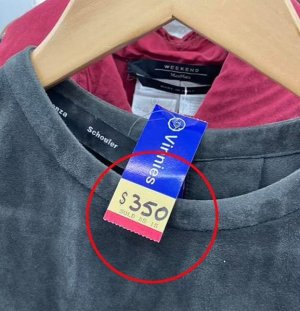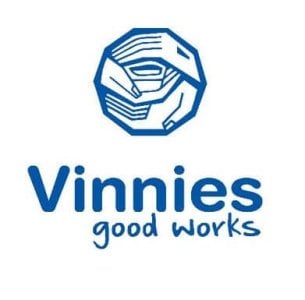You won't believe how much this T-shirt costs at Vinnies!
- Replies 34
Charity shops have long been a popular source of affordable and accessible clothing and household items, with these stores often providing quality items for Australians on a tight budget.
But a recent discovery at a Vinnies store has shoppers up in arms – and has prompted a conversation about the ever-increasing costs of second-hand goods.
A shopper at a second-hand charity clothes shop has been left stunned after finding a T-shirt that cost $350.
The clothing item is from a luxury brand called Proenza Schouler and was spotted at a Vinnies Store in Summer Hill in Sydney’s inner-west. This is the latest store to come under fire for its higher-than-normal price tags.
The shopper who discovered the item posted a photo of the price tag on Facebook and captioned: ‘I don’t know much about high fashion…Tell me, is this reasonable?’
It is believed that shirts from Proenza Schouler cost between AU $370 to AU $905 off the rack. However, it’s not uncommon to find some of their brand-new items priced anywhere between AU $1,000 to AU $3,000.
A worker at the store told reporters that the price was a ‘mistake made by a new employee’ and has been changed to its intended $100 price tag.
They also confirmed that the price had been amended after the store received some ‘comments’ from frustrated customers. ‘The price was supposed to be $100, but it's been fixed up now,’ they claimed.
‘It was accidentally mispriced by someone who is new. No one realised until it was pointed out [by customers],’ the worker added.
The St Vincent De Paul Society (colloquially known as Vinnies) states on their website that they’re ‘committed to actively and passionately speaking out against the causes of poverty and inequality’.
This charity shop has long been a place for impoverished members of the community to find second-hand clothes and goods at a bargain.
The photo of the item triggered a debate online about the increase in pricing found in charity shops across the country. According to some, what was once a source of affordable clothing has now become a stretch for ‘low-income people’.
‘It’s unfortunate,’ one responded before adding that it’s often cheaper to buy new items from stores including Kmart or Target, or fast-fashion brands online.
‘This Vinnies is ridiculous, the children's clothing is highly priced at times which is more expensive than say, Kmart. I shop there for children's clothing and the price of children's clothing is ridiculous. Even the toys can be ridiculously priced,’ added one.
Someone mentioned that seeing these prices was ‘concerning’. ‘I don’t shop there anymore, I used to love it. Their prices on even Target branded stuff is higher than at retail,’ they continued.
This comes after previous reports that Australia’s op shops are ‘caught up’ in the cost-of-living crisis. Clothing at church-run shops have items still being sold for as little as $2 or $3, but they find that some larger stores have put their prices up. Op shops such as the Salvation Army and Vinnies tend to have higher overhead costs, particularly rent, whereas others may not if they are based in locations owned by a church or other institutions.
The General Manager of Vinnies stores in Queensland said at the time that pricing is ‘typically decided by volunteers who follow guidelines that take into account the quality of donations, as well as the shop’s region’.
‘In higher-earning suburbs, the donations may be of higher quality and priced accordingly,’ he added before stating that ‘like all businesses, our costs have increased over the last few years’.
Omer Soker, CEO of Charitable Recycling Australia, told reporters that the second-hand economy is booming and that there are a few reasons for this.
He claimed that there’s a growing interest in sustainable shopping, especially since charity shops are also a source of discounted designer or vintage goods that people resell online for a profit. ‘Vintage is so cool right now so new shops that cater to that market are opening’ Mr Soker explained.
He also claimed that these ‘resellers’ are to blame for the price increases and said charities don’t increase the cost of goods.
‘These resellers buy from charity shops and then put on huge mark-ups to sell on commercial platforms like Depop, and other commercial markets. In these cases, charity shops are acting like wholesalers, so the charity shop prices are still great value,’ he said.
But he also pointed out that over 90 per cent of the 3,000 charity shops in Australia offer affordable, everyday items for millions of Australians – so, not all costs are going up everywhere.
Richard Wood, Head of Retail at Red Cross Australia, acknowledged that the sector is ‘changing’ as a result of increasing demand – particularly in metropolitan areas.
‘If you went back 10, 20 years ago, you would find that lots of people wouldn't want to admit they shopped in an op shop but would be happy to admit they donated,’ Mr Wood declared.
‘But now we are seeing a lot of people coming through that are really proud to say they are shopping at op shops,’ he added.
This shift in the demographics of consumers led the Red Cross to restructure its marketing model in some inner-city stores. However, he said that when it comes to pricing, there are three factors to consider:
First, the product needs to be of good value but it won’t always be ‘cheap’. ‘You might have a $50 Country Road item that is great quality and a lot of people wouldn't regard that as being cheap, but they could see that as really good value,’ he stated.
Second, he said he respects the intent of the person donating the item. He recalled an instance when he was in one of their stores and was next to a lady who picked something off the rack.
‘She sort of gasped at the product and thought the product was priced too low. She had donated that product and was disappointed that we weren't actually getting more for it,’ Mr Wood explained.
Finally, he considers the programs that the Red Cross supports through money raised in their shops.
‘The money that we raise through the shops goes to support those who are disadvantaged and vulnerable and they are often not in the areas where we have a shop.’
 Do you regularly shop at op shops or charity shops? Have you encountered higher-than-normal prices? Tell us what you think in the comments below.
Do you regularly shop at op shops or charity shops? Have you encountered higher-than-normal prices? Tell us what you think in the comments below.
But a recent discovery at a Vinnies store has shoppers up in arms – and has prompted a conversation about the ever-increasing costs of second-hand goods.
A shopper at a second-hand charity clothes shop has been left stunned after finding a T-shirt that cost $350.
The clothing item is from a luxury brand called Proenza Schouler and was spotted at a Vinnies Store in Summer Hill in Sydney’s inner-west. This is the latest store to come under fire for its higher-than-normal price tags.
The shopper who discovered the item posted a photo of the price tag on Facebook and captioned: ‘I don’t know much about high fashion…Tell me, is this reasonable?’
It is believed that shirts from Proenza Schouler cost between AU $370 to AU $905 off the rack. However, it’s not uncommon to find some of their brand-new items priced anywhere between AU $1,000 to AU $3,000.
A worker at the store told reporters that the price was a ‘mistake made by a new employee’ and has been changed to its intended $100 price tag.
They also confirmed that the price had been amended after the store received some ‘comments’ from frustrated customers. ‘The price was supposed to be $100, but it's been fixed up now,’ they claimed.
‘It was accidentally mispriced by someone who is new. No one realised until it was pointed out [by customers],’ the worker added.
The St Vincent De Paul Society (colloquially known as Vinnies) states on their website that they’re ‘committed to actively and passionately speaking out against the causes of poverty and inequality’.
This charity shop has long been a place for impoverished members of the community to find second-hand clothes and goods at a bargain.
The photo of the item triggered a debate online about the increase in pricing found in charity shops across the country. According to some, what was once a source of affordable clothing has now become a stretch for ‘low-income people’.
‘It’s unfortunate,’ one responded before adding that it’s often cheaper to buy new items from stores including Kmart or Target, or fast-fashion brands online.
‘This Vinnies is ridiculous, the children's clothing is highly priced at times which is more expensive than say, Kmart. I shop there for children's clothing and the price of children's clothing is ridiculous. Even the toys can be ridiculously priced,’ added one.
Someone mentioned that seeing these prices was ‘concerning’. ‘I don’t shop there anymore, I used to love it. Their prices on even Target branded stuff is higher than at retail,’ they continued.
This comes after previous reports that Australia’s op shops are ‘caught up’ in the cost-of-living crisis. Clothing at church-run shops have items still being sold for as little as $2 or $3, but they find that some larger stores have put their prices up. Op shops such as the Salvation Army and Vinnies tend to have higher overhead costs, particularly rent, whereas others may not if they are based in locations owned by a church or other institutions.
The General Manager of Vinnies stores in Queensland said at the time that pricing is ‘typically decided by volunteers who follow guidelines that take into account the quality of donations, as well as the shop’s region’.
‘In higher-earning suburbs, the donations may be of higher quality and priced accordingly,’ he added before stating that ‘like all businesses, our costs have increased over the last few years’.
Omer Soker, CEO of Charitable Recycling Australia, told reporters that the second-hand economy is booming and that there are a few reasons for this.
He claimed that there’s a growing interest in sustainable shopping, especially since charity shops are also a source of discounted designer or vintage goods that people resell online for a profit. ‘Vintage is so cool right now so new shops that cater to that market are opening’ Mr Soker explained.
He also claimed that these ‘resellers’ are to blame for the price increases and said charities don’t increase the cost of goods.
‘These resellers buy from charity shops and then put on huge mark-ups to sell on commercial platforms like Depop, and other commercial markets. In these cases, charity shops are acting like wholesalers, so the charity shop prices are still great value,’ he said.
But he also pointed out that over 90 per cent of the 3,000 charity shops in Australia offer affordable, everyday items for millions of Australians – so, not all costs are going up everywhere.
Richard Wood, Head of Retail at Red Cross Australia, acknowledged that the sector is ‘changing’ as a result of increasing demand – particularly in metropolitan areas.
‘If you went back 10, 20 years ago, you would find that lots of people wouldn't want to admit they shopped in an op shop but would be happy to admit they donated,’ Mr Wood declared.
‘But now we are seeing a lot of people coming through that are really proud to say they are shopping at op shops,’ he added.
This shift in the demographics of consumers led the Red Cross to restructure its marketing model in some inner-city stores. However, he said that when it comes to pricing, there are three factors to consider:
First, the product needs to be of good value but it won’t always be ‘cheap’. ‘You might have a $50 Country Road item that is great quality and a lot of people wouldn't regard that as being cheap, but they could see that as really good value,’ he stated.
Second, he said he respects the intent of the person donating the item. He recalled an instance when he was in one of their stores and was next to a lady who picked something off the rack.
‘She sort of gasped at the product and thought the product was priced too low. She had donated that product and was disappointed that we weren't actually getting more for it,’ Mr Wood explained.
Finally, he considers the programs that the Red Cross supports through money raised in their shops.
‘The money that we raise through the shops goes to support those who are disadvantaged and vulnerable and they are often not in the areas where we have a shop.’
Key Takeaways
- Many op-shoppers are frustrated with increasingly higher prices and believe charity shops are no longer an affordable option.
- A Vinnies shop in Sydney’s inner-west came under fire after a customer spotted a designer t-shirt for $350.
- The price was later amended to $100 due to customer feedback.
- The second-hand economy is booming and charity shops are offering more designer and vintage items at higher prices. It is believed that higher prices in charity shops are due to resellers and an increase in the cost of goods.









